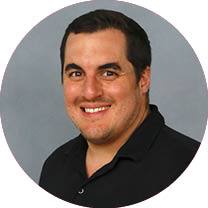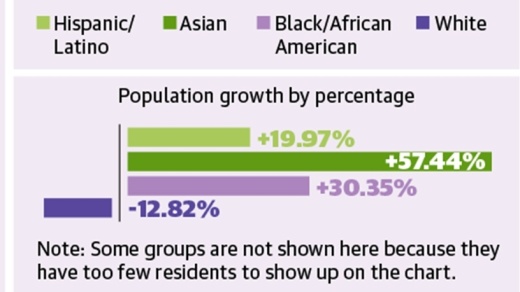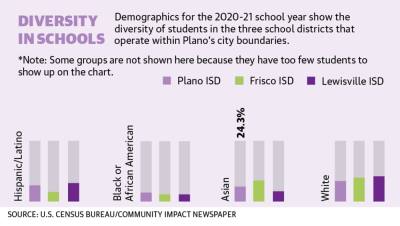Plano’s overall population grew by about 10% between 2010 and 2020, from 259,841 to 285,494. The number of residents who identify as white dropped from 151,629 to 132,194; however, all other racial and ethnic groups grew, according to the data.
In terms of race and ethnicity, the highest growth in both number and percentage occurred within the city’s Asian community. Between 2010 and 2020, the number of residents in this group grew by over 57%, from 43,659 to 68,738, according to the census.
“I don’t think there’s any question in the last 10 years Plano has become much more diverse,” Mayor John Muns said. “Even in the ‘90s we were a diverse community, but we have become even more diverse. Obviously, it is to our benefit.”
Muns said corporations like Toyota and JPMorgan Chase bringing their headquarters to Plano has factored into that increase in diversity.
“[Those companies] want to be in an area where there’s a real educated workforce,” Muns said.
Congressional and state legislative district boundaries are redrawn using population counts gathered by the census, according to the bureau. Because Plano City Council members are elected at-large, they are only required to redraw council boundaries if growth in any given district exceeds 25%.
City Attorney Paige Mims said the largest increase in any district was 11%.
A growing community
Census data shows that 1.5 million of the nearly 29 million people in Texas identify as Asian. This represents just over 5% of the state’s population.
In Plano, nearly 25% of the city’s residents identify as Asian.
Council Member Maria Tu was born in Taiwan and immigrated to America with her family in the early ‘70s. After becoming a lawyer, Tu said she moved to Texas with her husband, and together they opened the first company in North Texas to sell wholesale, to-go sushi in grocery stores.
For 27 years, Tu has lived in Plano and served in various community leadership roles. She was elected to council in 2019. Tu said business opportunities, city amenities and highly regarded school districts make Plano an attractive place to live, work and raise a family.
“A lot of ... Asian families are immigrants, so they like to live closer to each other because then they can coexist and lean on each other for support,” Tu said. “That eventually became sort of a snowball effect. Plano became the place to move to ... the place to be.”
According to the 2020 census data, more than 153,300 people in Plano identify as a race other than white.
The number of Plano residents who identify as two or more races saw an almost 98% increase, from 5,779 in 2010 to 11,429 in 2020. According to the bureau, the percentage of people who reported multiple races changed more than all of the other race groups alone in 2020.
The bureau expects much of this increase is due to changes in the way the census asks respondents to identify themselves. Changes to two separate questions for race and ethnicity, data process, and coding enabled a more “thorough and accurate description of how people prefer to self-identify,” according to the bureau.
For the 2020-21 school year, Plano ISD reported that its enrollment includes more than 12,000 Asian students, more than 13,000 Hispanic or Latino students and more than 6,500 Black or African American students. In total, this represents 63% of the district’s 50,154 total students.
Tu said increased diversity benefits the city as a whole.
“When you start looking at other cultures, and you take the time and effort to understand and learn, you start developing and ... generating new ideas and new progress. That’s how a city grows.”
Not all Plano residents speak English or use American social media platforms like Facebook and Instagram, Tu said. This is why Tu said she is advocating for Plano to find new ways to reach out to its ethnic communities.
Tu referenced the messaging app WeChat and the social media site Line as more prominent forms of online communication in some Asian communities.
“In order to reach out, we have to start looking at those alternative groups or channels,” she said. “Or just going to these communities where they gather and trying to get information that way.”
One such gathering is hosted by Plano nonprofit Celebrating Asian American Heritage Foundation. The group’s annual event, Asiafest, was held virtually in May and is one of the biggest Asian cultural festivals in Dallas-Fort Worth.
Reaching out
City officials plan to hold a “listening tour” early next year where council members and prominent city staff will hold Town Hall-style events to hear from community members they do not typically engage with.
Fifteen of the events will be held in person, while another five will be held virtually.
“We really want to hear from people that we don’t hear from on a regular basis,” Muns said. “The feedback that we can get from a broader part of our community, so that we can do things better if need be, is really important to me and the council.”
Exact dates have not yet been announced. Officials said more information will be available through social media and the city’s website.
Council Member Kayci Prince said it is paramount for city representatives to be accessible to all members of the community.
“Maybe there’s some real challenges [those communities] are facing that we don’t know about,” she said. “I’m really looking forward to hearing from people that haven’t had a seat at the table yet or haven’t known they have the opportunity to always have a voice.”
Plano resident Almas Muscatwalla is executive director of Faith Forward Dallas, a North Texas organization of diverse religious leaders. She said that regardless of background, Plano residents must take civic engagement seriously.
“If you want to be at the table, then you also have to be engaged in social issues,” she said. “You equally participate as a civil society to create and complement and supplement the worth of your governance.”
Muscatwalla said her past participation in Leadership Plano, a nine-month class that focuses on leadership techniques while exploring different aspects of the community, was vital to understanding Plano-specific issues.
She said events such as the annual Plano International Festival, modified this year due to COVID-19, are essential in bringing residents together.
And while census data may help illustrate Plano’s diversity, Muscatwalla said the numbers do not tell the whole story.
“Diversity is a reality of our life,” she said. “[Plano] embraces that diversity. Having these different cultures, different ethnicities and languages coming together really makes people better citizens of the world.”
Olivia Lueckemeyer contributed to this story








